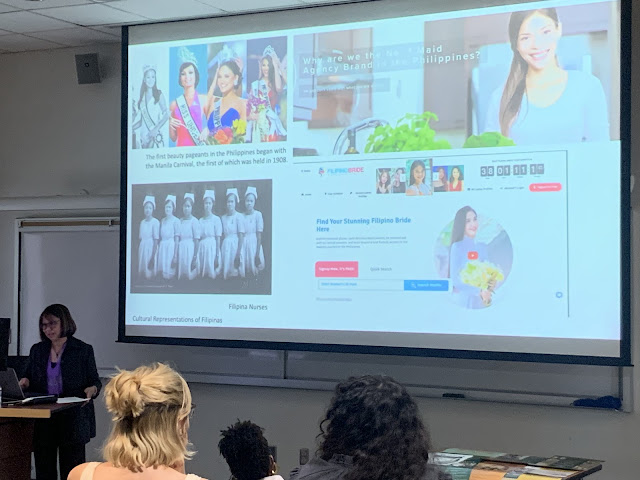Artist Keynote Speaker: Maryrose Cobarrubias Mendoza; Twentieth Annual Festival of the Arts Art History Symposium and Artist Lecture: Towards a Multiple Worldview; Remapping Paradigms of Modern and Contemporary Art
April 19, 2024
Artist Keynote Speaker: Maryrose Cobarrubias Mendoza, Associate Professor, Pasadena City College.
Sponsored by the Department of Art, University Galleries, Center for Teaching and Learning, and the College of Arts and Letters. In honor of Dr. Elaine O'Brien.
Artist Keynote Speaker Maryrose Cobarrubias Mendoza was introduced by student Julia Encinas.
In her presentation, Mendoza discussed the progression of her life's journey and how her experiences relate to the work she's created. She opened with a photograph of her parents, who came to the U.S. in 1965. The artist and her siblings followed shortly after in 1970. Topics of identity, cross-cultural gaze, and the search for connection are just a few things the artist contemplates when making her repurposed item images.
Working with found objects or objects close to her upbringing, refers to the community that these objects relate to, not just to her Filipino community, but to Asian Americans as a whole. Mendoza presented her works chronologically and connected them to events in her life. She finds inspiration through the progression of her experiences and processes her thoughts regarding them through her creation.
Working with found objects or objects close to her upbringing, refers to the community that these objects relate to, not just to her Filipino community, but to Asian Americans as a whole. Mendoza presented her works chronologically and connected them to events in her life. She finds inspiration through the progression of her experiences and processes her thoughts regarding them through her creation.
Maryrose Cobarrubias Mendoza took two questions:
1.) “Is your work research-based and what is the process?”
Her work is not research-based but sparked out of curiosity, "the more curious the more learned." Through books, she learns and doesn't know what to do with the information and the emotions presented with that information. “I couldn’t even look at [the Forbidden Book] for a really long time, when I found that space I decided that this is the time to make this work.” (In reference to her piece If These Walls Could Talk (2020-ongoing) which incorporates images from the Forbidden Book.)
2.) “Colonialism tends to creep in and influence asians to look and assimilate in a certain way even to a point of pride. Do you think there is a way to approach elders in addressing these are colonialist beauty standards that have skewed the cultural perspective?”
"It's my understanding of the 'why' they think that way. Be generous in thinking that they may not be able to change. Change can be seen in self-assertion and openness to other ways of thinking, sometimes that is enough to help soften rigidness in those areas."
1.) “Is your work research-based and what is the process?”
Her work is not research-based but sparked out of curiosity, "the more curious the more learned." Through books, she learns and doesn't know what to do with the information and the emotions presented with that information. “I couldn’t even look at [the Forbidden Book] for a really long time, when I found that space I decided that this is the time to make this work.” (In reference to her piece If These Walls Could Talk (2020-ongoing) which incorporates images from the Forbidden Book.)
2.) “Colonialism tends to creep in and influence asians to look and assimilate in a certain way even to a point of pride. Do you think there is a way to approach elders in addressing these are colonialist beauty standards that have skewed the cultural perspective?”
"It's my understanding of the 'why' they think that way. Be generous in thinking that they may not be able to change. Change can be seen in self-assertion and openness to other ways of thinking, sometimes that is enough to help soften rigidness in those areas."




Comments
Post a Comment